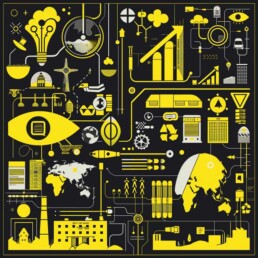Visual Communication Best Practices
How to get more from B2B communications.
In the congested world of B2B communications, effective visual communication is essential. With businesses inundated with information from all angles, compelling visual communication can cut through the noise, capture attention, and convey complex messages with clarity and impact.
Why visual communication? Because our brains are wired to retain visual information more effectively, making it more likely to leave a lasting impression compared to text alone. Visual stimuli is processed within milliseconds, unlike the more time-consuming cognitive effort required for the comprehension of text.
Complex ideas and technical information can be overwhelming. Distilling messages into clear, concise visuals that are easy to understand at a glance greatly increases engagement and understanding. Clutter, too much information and unnecessary complexity on the other hand reduce cohesion and lose people’s attention.
Visual Consistency Across Channels
Consistency isn’t just about maintaining a uniform look and feel across platforms—it’s about creating a visual language that resonates with your audience. When every graphic element, typeface choice, and colour palette align seamlessly, they form a narrative that speaks volumes about your brand’s identity and values.
Think of your visual consistency as the silent ambassador of your brand, communicating your professionalism, attention to detail, and commitment to quality without uttering a word. It’s the reassuring handshake that greets your audience across every digital touchpoint, instilling a sense of trust and reliability in your brand.
In essence, visual consistency isn’t just a matter of aesthetics; it’s a strategic imperative that shapes the reputation of your brand. By mastering the art of visual storytelling through consistent design elements, you’re not only strengthening brand recognition but also building trust and respect.
Use Data Visualization Effectively
In the B2B ecosystem, where data governs decision-making, the challenge lies not only in collecting and analysing vast amounts of data but also in effectively communicating its insights to key stakeholders. This is where data visualisation becomes a powerful tool, transforming raw data into visual narratives that are not only easy to digest but also compelling to engage with.
By harnessing data visualisation techniques such as charts, graphs, and infographics, B2B communicators can distil complex data sets into intuitive visual representations. These visuals serve as a bridge between the intricacies of data analysis and the understanding of decision-makers, enabling them to grasp key insights at a glance and make informed choices.
Data visualisation goes beyond mere comprehension; it injects life into dry stats, transforming them into dynamic stories that relate to the audience. By presenting data in a visually appealing manner, B2B communicators can capture the attention of their audience, driving deeper engagement and leave a lasting impression. Whether it’s a compelling chart that highlights a trend or an infographic that breaks down complex information into digestible chunks, data visualisation elevates the impact of B2B communications, making them more memorable and impactful.
Embrace Photographic Storytelling
As the saying goes, a picture is worth a thousand words, and the strategic use of real photography has far more value than mere visual aesthetics. It can communicate many messages in an instant and acts as a medium for connection and engagement with your audience – none of which can be achieved with stock photography.
Authenticity is the cornerstone of effective communication, and candid professional photography epitomises this ethos by offering a glimpse into who you are. By showcasing real employees, genuine workplace environments, and authentic interactions, businesses can bring a human face to the name, cultivating trust, credibility and relatability.
Genuine photography provides businesses with a unique opportunity to differentiate themselves in a sea of sameness. In a world saturated with generic stock and AI imagery, authentic visuals demonstrate sincerity and integrity, setting themselves apart as genuine, relatable, and trustworthy partners in business.
